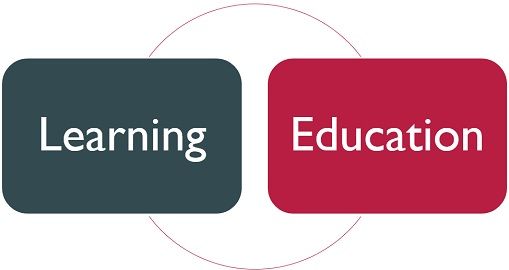 Learning is automatic, i.e. we see things, we observe them and then learn something new through our experiences in our day to day life. So, it is a continuous process and also a life long one. Learning can be intentional or unintentional, conscious or unconscious, for better or for worse.
Learning is automatic, i.e. we see things, we observe them and then learn something new through our experiences in our day to day life. So, it is a continuous process and also a life long one. Learning can be intentional or unintentional, conscious or unconscious, for better or for worse.
On the other hand, the word ‘education’ is interpreted differently by different human beings. While for some it is a synonym for formal schooling, others take it as lifelong learning. There are also people for whom education means obtaining knowledge, skills and attitude.
Education refers to a formal conservative process that helps in the development of abilities, attitudes and other behavioural practical values in the society from which they belong, for the purpose of obtaining social competence and optimum development of an individual’s potential.
In this write-up, we will go through the differences between learning and education in a detailed manner.
Content: Learning Vs Education
Comparison Chart
| Basis for Comparison | Learning | Education |
|---|---|---|
| Meaning | Learning refers to an intellectual process of acquiring new skills and knowledge, through experience, study or teaching. | Education is an enlightening process of receiving and providing knowledge, through systematic instruction. |
| Type of Process | Natural Process | Deliberate Process |
| Guidance | May or may not be required | Required |
| Elicited by | Intrinsic Motivation | Extrinsic Motivation |
| Purpose | To regulate future actions and develop new knowledge. | To bring certain desirable changes in the behavior of the student. |
| Nature of Process | Unsystematic | Systematic |
| Age-factor | Learning is a life long process. | Persons of different age groups can enroll themselves to get education. |
Definition of Learning
Learning can be defined as the long term change in behaviour due to experience or practice. So, any change in the behaviour which is only for a short term, caused by instinct or maturation, illness or fatigue, it cannot be called learning. Here, the essence of learning is ‘experience’. It helps an individual in adjusting according to the surrounding environment. Secondly, learning is exhibited in the behaviour or activities of the person, which could not be observable.
Features of Learning
- It is a change in behaviour that can be better or worse.
- The change occurs due to practice or experience, however, changes occurring because of growth or maturity are not called learning.
- The change in behaviour has to be permanent, which must last a fairly long time.
- It involves some kind of experience.
- It is a universal process.
- It is purposeful and goal-oriented.
- It is transferable from one situation to another.
Basically, learning connotes a reflective activity that facilitates a learner to recall their previous experience to discern and evaluate the present, in order to devise future action and add new knowledge.
Also Read: Difference Between Active and Passive Learning
Definition of Education
Education refers to a purposive, psychological and scientific process that results in the development of a student to the maximum extent. Not just this, it brings about maximum development of the society, in a manner, that the highest level of happiness and prosperity can be enjoyed by both. So we can say that education is the advancement of the student as per society’s need and demand.
- The main purpose of education is to attain the mental development of the child.
- It is a process with the help of which knowledge, character and behaviour of the student is shaped and moulded.
- It tends to influence the environment of the individual so as to make a long-lasting change in the habits of the individual’s behaviour and attitude.
Education is a developmental process in which an individual slowly adapts himself in different ways to his physical, social and spiritual environment. In the broadest sense, education is something that has a positive impact on the mental, physical and psychological well being of the individual.
Also Read: Difference Between Training and Education
Key Differences Between Learning and Education
Now that you have a complete idea of what is learning and what is education. Here is a complete list of the difference between learning and education:
- Learning is a process that results in relatively long-lasting changes in the individual’s behaviour by way of training and experience. On the other hand, education is a systematic process of imparting or gaining knowledge, developing the basic skills of reasoning and judgement and preparing an individual to live a matured and mannered life.
- Learning is a natural or coincidental process, i.e. a person learns many things daily and that is not purposeful. In contrast, education is deliberate in the sense, that one has a clear idea of the fact that they are being educated by enrolling on that particular course or going to that particular institution.
- Learning can take place with or without any guidance. However, in the case of education, the presence of a guide, teacher or instructor is a must.
- While learning is elicited by intrinsic motivation, education requires extrinsic motivation.
- Learning is a process wherein the learner links new experience to the old one as well as make room for and absorb new ideas in his/her mind, so as to regulate future actions. On the contrary, Education can help in bringing certain desirable changes in the behaviour of the student.
- Education is a systematic process in the sense that it is provided through a planned and formally designed curriculum by the experts, through the educational institution. Conversely, learning is unsystematic, i.e. one can learn by simply observing and connecting the experiences.
- Learning is a life long process, this means that there is no age bar to learn something, i.e. even at the age of 90 one can learn how to cook, or how to sing or how to play ludo. But in the case of education, people of different age groups can enrol themselves at the educational institution, to receive an education.
Types of Learning
The various types of learning are given as under: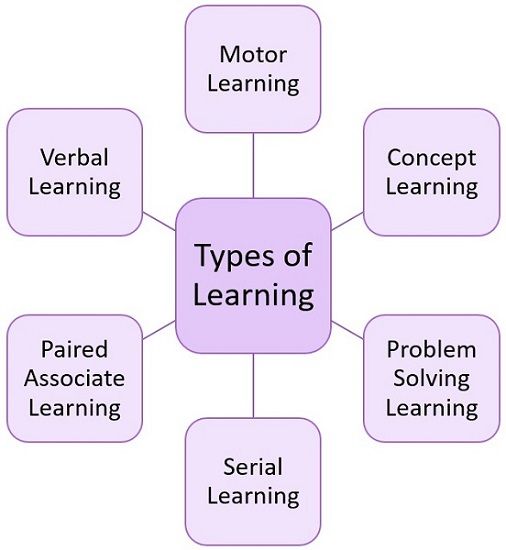
- Verbal Learning: This form of learning helps in acquiring verbal behaviour, such as the language we speak, the communication devices that we use, etc. It makes use of signs, symbols, figures, words and pictures, so as to engage in the process of verbal learning.
- Motor Learning: Learning of various types of motors, instruments or machines is covered under this category. It may include learning such as swimming, riding a horse, car driving, performing experiments, flying a plane, playing the piano, etc.
- Concept Learning: An image that we have created in our mind, concerning things, people or events, is concept learning. For instance: our concept of the pen is nothing but a mental image, that has some basic characteristics of all the pens we have encountered. So we call something a pen, when that thing has the same characteristics, that we have in our mind.
- Problem Solving Learning: In the learning echelon, problem-solving learning is at the top, which calls for the use of cognitive abilities such as critical thinking, reasoning, comprehension, observation, generalization, inference, etc.
- Serial Learning: In this form of learning the learner is presented with the learning material that showcases a particular sequential order. This is often found in school education, where students are expected to be proficient in the study/course material.
- Paired Associate Learning: Learning tasks are introduced in a manner that they may be experienced or studied on account of their associations.
Modes of Education
The three main modes of education are: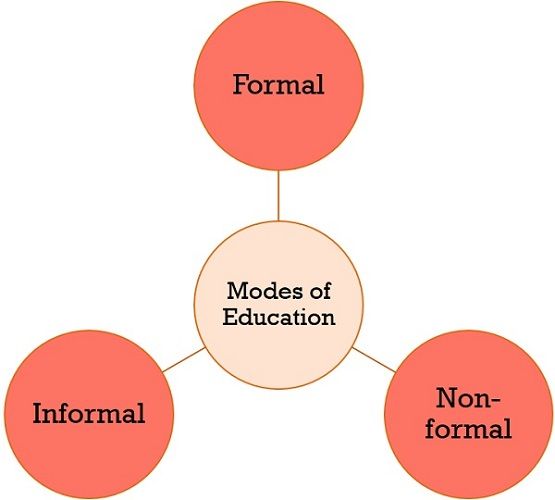
1. Informal Education: When education is acquired by a person from any source other than the source which is primarily meant for imparting education, like exposure to experiences like films, web series, travelling, newspapers, social media, etc. is called informal education. This is not structured, as well as it will not ensure certification of any kind. It may be conscious or unconscious, accidental or incidental.
2. Formal Education: When the education provided by institutions specially developed for this purpose, it is called formal education. The institutions may include schools, colleges, academic institutions, etc. It is regarded as the most popular as well as an effective mode of education, which helps in the development of the individual’s capabilities, by passing the right set of knowledge from one generation to another, exploring new knowledge and ideas, etc. It can be: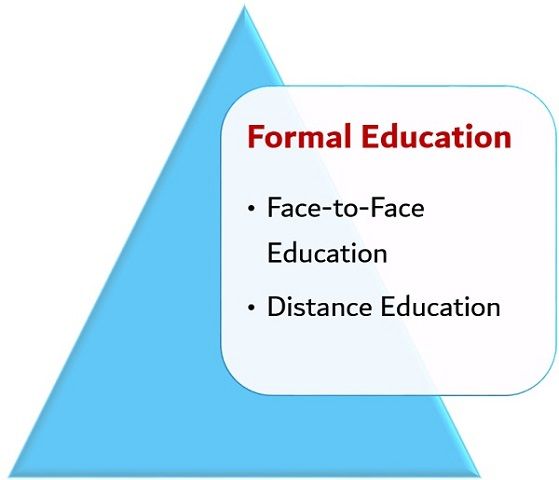
- Face to Face Mode: When there is direct communication between the instructor and the student, such that they are facing each other, it is called as face to face mode of education. This exists in the case of classroom teaching, wherein the teacher and students are physically present, to impart and receive education respectively.
- Distance Education Mode: As the name itself signifies, it is the mode of education wherein the students get an education even from remote areas, by connecting with the teacher from different communication modes. Therefore, in such a mode of education, the teacher and student are located at different geographical locations. Further Distance Education is provided through different means:
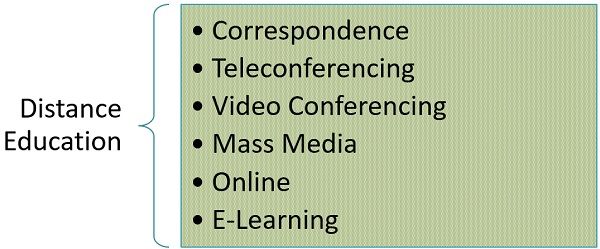
- Correspondence: In this mode, the educational institution develops the study material and CDs which is learner-friendly and sends the same to the students. Further, the student’s progress is monitored by way of assignments.
- Teleconferencing: A mode of education in which the teacher and student are connected using satellite and they can interact with each other through communication technology.
- Video Conferencing: Quite similar to teleconferencing, wherein both student and teacher can see and talk with each other, however, geographically they are miles apart. For this purpose, platforms like Skype, Zoom and satellite-based two-way interaction system are used.
- Mass Media: Television, newspaper and radio are used to provide distance education to the students. Various television and radio programmes of educational nature are aired to impart education to the students living in remote areas.
- Online: In online education, the students get education at their convenience, i.e. the entire course material is uploaded on the institution’s official website and the link is shared with the students or even sent to the student’s email and they can download and enjoy this facility.
- e-Learning: e-Learning is a computer-based mode of education, wherein the student is provided with interactive material and e-books. Information and communication technology is used for the purpose of e-Learning.
3. Non-Formal Education: There are numerous programmes like awareness campaigns, adult literacy, and so forth which do not fall under the category of formal education, but these have equal importance, as well as they conducted with specific aims and objectives. Such a form of education is non-formal education. It is a combination of formal and informal education wherein the education is provided informally but in a formal environment. It can take place both inside and outside the institution campus.
Conclusion
Learning is a process, that has a crucial role to play in shaping the structure of our personality and behaviour of a person. As against, education is a system of learning which aims at maximizing the all-round development of the student, as well as to cause socialization of individuals to remove taboo and stereotypes from the society.






Asaad ahmed says
Your research is very beautiful and useful
Thank you very much
Mohan Inder Singh Chauhan says
Your understanding of the subject is outstanding. You have put across everything in the simplest way, which can be understood by any average person.
David says
The method of description is simple and understandable. Thank you for your research.
Dr. P. Pinakapani says
The method of explaining the basic concepts is excellent wherein a layman can also understand. Please give examples for each concept
Huda Ahmed says
Very interesting and useful , thank you.